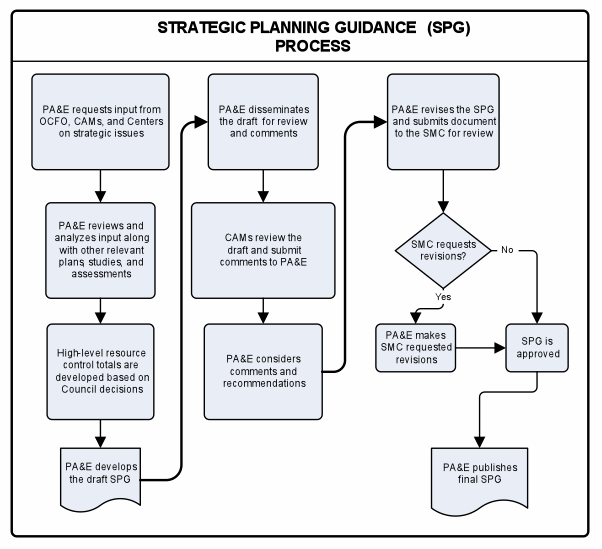Chapter 2. Planning
2.1 Overview
2.1.1 The Agency’s planning activities include analyzing changing internal and external conditions, trends, threats, and technologies that will affect NASA; examining alternative strategies for adjusting to these changes and conditions; and defining long-term strategic goals, multi-year outcomes, and short-term performance goals that will challenge and enable the Agency to achieve its mission. Planning activities also include developing NASA’s performance measurement strategy and specific metrics that will be used to monitor, assess, and report on the Agency’s progress toward achieving these goals. The Planning Phase produces the NASA Strategic Plan (NPD 1001.0) every three years, produces implementation plans, and updates to the NASA Governance and Strategic Handbook (NPD 1000.0). This phase also produces NASA’s annual and strategic performance, program, and project goals, and a description of desired outcomes. NASA uses these products and other data to create the annual SPG, which provides the basis for development of the Agency’s annual budget request. The SPG is the first step in the budget formulation process.
2.2 Strategic Planning Guidance (SPG)
2.2.1 Purpose. In the SPG step of the Planning Phase, PA&E consolidates all of the information from the Strategic Plan, implementation plans, priorities, studies and assessments, and performance measures into strategic guidance for the Control Account Managers (CAMs). CAMs use this information to design their programs/projects to achieve Agency strategic goals and provide the institutional and management structure in support of those goals. Consolidating all relevant guidance into one concise document provides uniform direction for the Agency. The SPG also provides high-level resource guidance that includes the initial funding controls based on decisions from a SPG senior managers’ review of new or open issues, disconnects, revisions needed to address OMB settlement, and the Acquisition Strategy Planning (ASP) review. The SPG provides high-level program and institutional guidance on the strategic priorities, directions, and assumptions to develop budgets and performance measurements. The SPG is focused on the budget year + 4 outyears and can request data for projects extending into the future and plan for new initiatives, but it is not used to review competitive project selection within existing programs. The SPG also contains the Annual Performance Planning (APP) guidance for development of the performance commitments which manifest in the pages of the CBJ. Each discrete performance piece is assigned a measurement strategy and then commitments are set accordingly, accounting for Congressional and White House interest and policy, required activities to achieve the strategic goals & Agency plans, past performance issues, internal program and project planning and control policies (i.e. NPRs 7120); and consistency with other internal and external performance commitments.
2.2.2 Process. PA&E compiles all open issues and actions from the last budget submit that need to be addressed in the upcoming budget to ensure each is addressed in the SPG. In addition, PA&E requests input from the OCFO, Office of Program and Institutional Integration (OPII), Mission Directorates (MDs), Mission Support Offices (MSOs), and Centers on “disconnects” and issues that they recommend the SPG address, as well as any special templates to collect data. PA&E reviews and analyzes input provided along with the Strategic Plan, implementation plans, and various relevant studies, reports, and assessments. After review of all inputs, PA&E develops the draft SPG, including the high-level resource controls developed by OCFO, and provides the draft to OCFO, and the CAMs for review and comment. PA&E then reviews the comments and makes changes to the draft, as appropriate. Disconnects and issues that could affect the SPG are presented to the Strategic and Program Management Councils (S/PMC) for decision. Then, the SPG is updated and presented to the SMC, any changes required by the Council are incorporated, and the final SPG is approved by the SMC. PA&E posts the approved SPG to the eBudget Clearinghouse. An illustration of the SPG process is provided in Figure 2-1.

Figure 2-1, SPG Process
2.2.3 Timeline. This step is completed in February of each year. Typically, SPG development begins before receipt of the passback from OMB and is officially released internally to the NASA CAMs and OCFO at the same time the President’s Budget is released in early February.
2.2.4 SPG Responsibilities.
2.2.4.1 CAMs. Review and provide comments on the draft SPG.
2.2.4.2 Centers/Mission Support Offices. Provide input to their CAM on issues that need to be addressed in the SPG.
2.2.4.3 OCFO. Provide input to PA&E on the draft SPG.
2.2.4.4 OPII. Integrate comments and issues from the Centers and Mission Support Offices.
2.2.4.5 PA&E. Develop the NASA priorities in conjunction with the Administrator. Request pertinent input and develop the draft version of the SPG, including templates for all formal reports required during the Programming Phase. Submit draft to OCFO and CAMs for review and comment. Address comments received and develop revised draft SPG. Present revised draft SPG to the S/PMC and make any requested revisions. Post final SPG to eBudget Clearinghouse.
DISTRIBUTION:
NODIS
This Document is Obsolete and Is No Longer Used.
Check the NODIS Library to access the current version:
http://nodis3.gsfc.nasa.gov
![[NASA Logo]](../Images/nasaball.gif)
